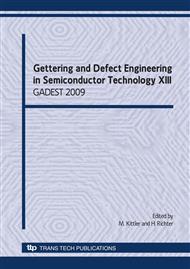p.289
p.295
p.299
p.305
p.313
p.319
p.325
p.331
p.337
Boron and Phosphorus Implantation Induced Electrically Active Defects in p-Type Silicon
Abstract:
Electrically active defects induced by ion implantation of boron and phosphorus into silicon and their recovery under isothermal annealing at 450 °C were investigated using Deep Level Transient Spectroscopy (DLTS) and Energy Resolved Tunneling Photoconductivity (ERTP) spectroscopy at cryogenic temperatures. DLTS results show electrically active deep traps located at Ev+0.35 eV and Ev+0.53 eV in boron implanted Si and at Ev+0.34 eV, Ev+0.43 eV, and Ev+0.38 eV in phosphorus implanted Si. These meta-stable defect sites were found to be either eliminated or significantly reduced in thermally annealed samples. We assigned these defect sites to hydrogen and carbon incorporated complexes formed during ion implantation. Corroborating the DLTS results, the photocurrent measurement also revealed a strong reduction of electrically active defects states, extended from EC – 0.3 eV up to the conduction band edge of Si, upon isothermal annealing.
Info:
Periodical:
Pages:
313-317
Citation:
Online since:
October 2009
Keywords:
Price:
Сopyright:
© 2010 Trans Tech Publications Ltd. All Rights Reserved
Share:
Citation:


